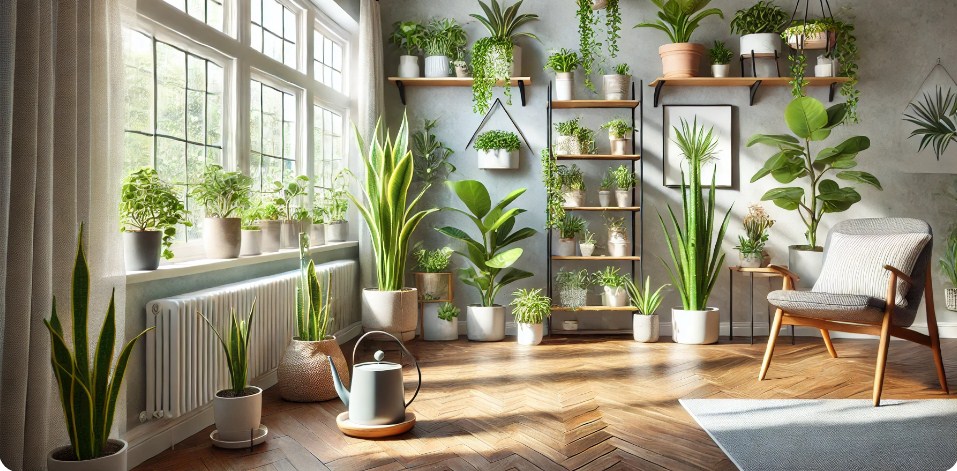Bringing greenery indoors is one of the easiest ways to add life, color, and calmness to your home. Indoor plants purify the air, reduce stress, and enhance your living space with a natural touch. If you’re new to indoor gardening, choosing the right plants is essential to build confidence and avoid frustration.
This article highlights the best indoor plants for beginners and provides simple care tips so you can enjoy your indoor jungle with ease.
Why Choose Indoor Plants?
Indoor plants offer many benefits beyond aesthetics:
-
Air purification: Many common houseplants filter toxins and increase oxygen.
-
Mental health: Caring for plants has been linked to lower anxiety and improved mood.
-
Productivity: Studies show that plants in workspaces can boost concentration.
-
Easy decor: They enhance interior design effortlessly.
With the right selection, anyone can succeed at indoor gardening — even without a green thumb.
What Makes a Plant Beginner-Friendly?
Not all indoor plants are low-maintenance. Some are fussy about light, humidity, or watering schedules. Beginner-friendly plants share a few key traits:
-
Tolerant of low light
-
Require minimal watering
-
Resistant to pests
-
Forgiving if neglected
Now, let’s explore some of the best options!
1. Snake Plant (Sansevieria)
The snake plant, also known as mother-in-law’s tongue, is a top choice for beginners. With its tall, sword-like leaves and striking appearance, it’s also one of the hardest plants to kill.
Care Tips:
-
Light: Thrives in low to bright indirect light.
-
Water: Every 2–3 weeks; let the soil dry out completely between waterings.
-
Bonus: Great air purifier and tolerates neglect.
2. ZZ Plant (Zamioculcas zamiifolia)
If you often forget to water your plants, the ZZ plant is your best friend. It has thick, waxy leaves that store moisture, allowing it to go weeks without care.
Care Tips:
-
Light: Low to medium indirect light.
-
Water: Once every 2–4 weeks.
-
Bonus: Tolerates low humidity and poor lighting.
3. Pothos (Epipremnum aureum)
Pothos is a vining plant with heart-shaped leaves that come in a variety of colors and patterns. It’s a fast grower and looks beautiful in hanging baskets or cascading down shelves.
Care Tips:
-
Light: Low to bright indirect light.
-
Water: Once the top inch of soil is dry.
-
Bonus: Can be propagated easily in water.
4. Spider Plant (Chlorophytum comosum)
The spider plant is another easy-care favorite that produces “babies” or plantlets that can be replanted or shared. It’s resilient and can thrive in many conditions.
Care Tips:
-
Light: Bright, indirect light preferred.
-
Water: Weekly, allowing the soil to dry slightly between waterings.
-
Bonus: Non-toxic to pets and kids.
5. Peace Lily (Spathiphyllum)
Known for its graceful white blooms, the peace lily adds elegance to any room while also acting as a natural air filter.
Care Tips:
-
Light: Prefers medium to low indirect light.
-
Water: Once a week or when leaves start to droop.
-
Bonus: Tells you when it needs water by wilting slightly.
6. Aloe Vera
This succulent is both attractive and functional. The gel inside its leaves is often used to treat minor burns and skin irritations.
Care Tips:
-
Light: Needs bright, indirect light.
-
Water: Every 2–3 weeks; ensure good drainage.
-
Bonus: Medicinal and very low-maintenance.
7. Chinese Evergreen (Aglaonema)
A stylish plant with patterned leaves that’s perfect for adding a pop of color to darker rooms.
Care Tips:
-
Light: Tolerates low light very well.
-
Water: Let the top two inches of soil dry before watering.
-
Bonus: Available in many leaf colors, from silver to pink.
8. Rubber Plant (Ficus elastica)
With its thick, glossy leaves, the rubber plant makes a bold statement. It can grow quite large indoors if given the right care.
Care Tips:
-
Light: Bright, filtered light.
-
Water: Once the top layer of soil is dry.
-
Bonus: Fast-growing and easy to prune.
Tips for Successful Indoor Gardening
Getting started with indoor plants is simple, but a few extra tips can help you avoid mistakes and keep your green friends happy.
Use the Right Pot
Make sure each plant is in a pot with drainage holes to prevent overwatering and root rot.
Don’t Overwater
This is the most common mistake. Most indoor plants prefer to dry out a bit between waterings.
Clean the Leaves
Wipe dust off leaves with a damp cloth every few weeks. This helps the plant breathe and improves its look.
Monitor Light Levels
Watch how sunlight enters your room throughout the day. Rotate plants occasionally so they grow evenly.
Repot When Needed
As your plants grow, they’ll need bigger pots. Repot every 1–2 years to give roots more space.
Common Problems and How to Fix Them
Even easy-care plants may show signs of stress. Here’s how to troubleshoot common issues:
Yellow Leaves
Could be overwatering or poor drainage. Let soil dry out more before watering again.
Brown Leaf Tips
Usually due to dry air or low humidity. Mist the plant or use a humidifier nearby.
Drooping Leaves
Often a sign of either under- or overwatering. Check the soil before reacting.
Pests (like gnats or spider mites)
Use insecticidal soap or neem oil and avoid overwatering, which attracts pests.
Creating an Indoor Jungle: Final Thoughts
You don’t need a green thumb to enjoy the magic of indoor plants. With a handful of easy-to-grow species and basic knowledge, anyone can turn their home into a lush, calming retreat.
Start with one or two beginner-friendly plants and build from there. As your confidence grows, so will your collection — and your appreciation for the beauty and simplicity of caring for living things.
